BY DAVID DAVIS
 THE COACH: Director Jimmy Moore in the control room with
THE COACH: Director Jimmy Moore in the control room with
more than 100 screens blinking. (Credit: Wendi Kaminski)On a sunny April morning, the Phoenix Suns and L.A. Lakers are warming up inside Staples Center in downtown Los Angeles before Game 4 of their NBA playoff series. The Lakers' Kobe Bryant, the league's leading scorer, rises to launch his accurate jump shot again and again—swish—while Suns' point guard Steve Nash, the league's two-time Most Valuable Player, stretches his creaky back near midcourt. The palpable tension in the building reflects the high stakes of the game: if Nash can lead the Suns past Kobe and the Lakers, Phoenix will open up a commanding 3-1 lead in the best-of-seven series.
Minutes before tipoff, as Jack Nicholson, Dyan Cannon, and Magic Johnson settle into their courtside seats, a similar excitement is brewing inside the nondescript truck that sits on the parking lot ramp outside the Staples Center. There, in the air-conditioned chill of the tight-quartered production trailer, ABC Sports director Jimmy Moore glances at the bank of more than 100 tiny TV consoles blinking in front of him and speaks softly with his producer Ken Wolfe, who sits next to him. In addition to the teams on the court, Moore's directing team, consisting of associate director Bradley Wilson, stage managers Jay Zabriskie in the truck and Melissa Horton in the arena, is ready to go.
Moore has stationed 14 cameras within Staples Center to capture every angle of the action, and he has assembled several opening sequences to establish the sense of the moment. The 75-person production crew is poised to go live instantly, but as he awaits the conclusion of the Chicago Bulls versus the Miami Heat, ABC's first televised game of the day, nobody, least of all Moore, knows exactly how much time he'll have before the start of the game in L.A.
Suddenly, Wilson, the associate director, gets the word from master control in New York: because the Bulls-Heat game is running long, Moore will be live for seconds, not minutes, before the tipoff at Staples. That means the director will have to jettison almost everything that he had prepared for his pre-game package—including the Southern California exteriors that were taped the day before and a musical interlude from the all-girl music group the Pussycat Dolls.
Moore scans the screens in front of him, watching carefully as the announcers in Miami make their final comments. A compact man with a lilting Southern twang, Moore takes a final swig from his water bottle. Wilson counts down the remaining seconds to air as the and then Moore begins to bark rapid-broadcast comes out of commercial break,fire instructions: "Give me my tease. Now, roll X. Go font one, go font two. Standby Skycam, now go [camera] 16. Go, Joe, camera two. Take [camera] two, take [camera] one. A little wobbly, Frank."
Sitting to Moore's right, the technical director executes his boss' direction and punches buttons on the console in front of him, signaling which camera's pictures will be shown to the viewers at home. Moore's instructions also include the many taped elements and instant replay sequences put together in an adjacent second truck, as well as the graphics that flash the score, the game clock, and other factual information.
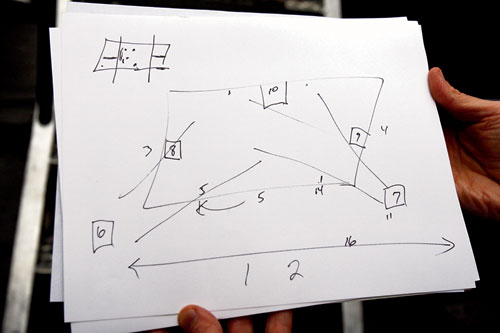 THE GAME PLAN: Moore's diagram for the placement of his
THE GAME PLAN: Moore's diagram for the placement of his
14 cameras. (Credit: Wendi Kaminski)For the TV viewer settling into his BarcaLounger at home, Moore's chopped comments translate into a seamless, tightly choreographed montage onscreen. Beneath a peppy musical theme and the pre-game banter of play-by-play announcer Mike Breen and analyst Jon Barry, an exterior shot of spectators streaming into Staples establishes the location. Moore then takes the viewer inside the arena, with close-up shots of the two superstars on the court: Bryant, slapping hands with Phoenix's starting five and hugging his teammates; and Nash, his face stoic beneath a helmet of unkempt brown hair. Graphics pop up to identify the opposing coaches who appear in close-up—Phil Jackson of the Lakers and Mike D'Antoni of the Suns—and Moore even finds an opening to insert flashes of the Pussycat Dolls' dance number that pumps energy to the opening.
The splashy intro concluded, Moore then guides the broadcast back to the court by training his cameras on the rest of the players in quick succession. The anticipation mounts with every cut as the crowd within the arena starts to roar, until the tipoff, when Moore pulls back to his primary game-action view." Go camera one," he barks and settles into the hustle-and-flow rhythm of the game.
In the truck, the nervous energy that has been building since the Lakers defeated the Suns in Game 3 dissolves into steely professionalism. The game is on and, for the next three-plus hours, so is Moore.
Directing live sports events for television is not for the faint of heart. The job demands technical knowledge of state-of-the-art, high-definition cameras, as well as the skills to make seat-of-the-pants adjustments for the unexpected that routinely happens in athletics. It requires a knack for storytelling, vast amounts of arcane sports knowledge, and the ability to edit a television show live. It also necessitates massive travel duty, often during the holidays.
"It's the closest thing to actually playing the sport," Moore says, "because you have to think with the athletes, you have to know what's coming, you have to be ready for the what ifs? That's a big question for me: What if Kobe is thrown out? What if Phil Jackson gets upset? We've got to be ready."
According to Moore, each broadcast serves two distinct purposes. "The main thing we offer is proper documentation of the event," he says. "The game has to be first because that's what everybody's tuning in for. So, our number one priority is ball coverage. Second, we're storytellers. Even as we're documenting the event, we need to make people care about these players and about this game. We use all the tools at our disposal: the talent, the cameras, the graphics, the music, the instant replays from different angles."
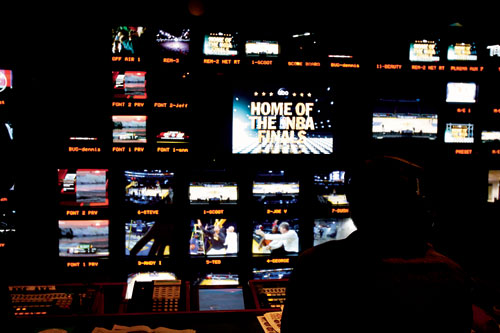 BALL CONTROL: The director calls the shots from the control
BALL CONTROL: The director calls the shots from the control
room during the game. (Credit: Wendi Kaminski)Moore, 48, has worked in television since the early 1970s, when he did "every job" at the ABC affiliate his father operated in Jackson, Miss. He started directing live news shows when he was 17 before graduating to sports, first as a technical director, then as a director of college football and basketball games throughout the South. He joined ESPN in the mid-'80s and has directed Major League Baseball for the network since 1990, as well as covering everything from soccer's World Cup to yachting's America's Cup. To date, the highlight of his directing career was helming the Sunday Night Baseball broadcast that featured Mark McGwire's dramatic 61st home run in 1998. (He was nominated for an Emmy for the show.)
In 2002, Disney-owned ESPN and ABC agreed to pay $2.4 billion over six years for the television broadcast rights to NBA regular-season and playoff games. Moore has been part of the networks' pro basketball team for the past five years, traveling to one Canadian and 28 American cities with NBA franchises.
This year, for the first time, Moore directed ABC's coverage of The NBA Finals in June. These Lakers-Suns playoff games in April, then, served as early plot twists in the months-long reality show that Moore develops. According to producer Wolfe, "It's more fun [in the playoffs] because you're building a story. It's like doing a series on TV. Your story lines are building and changing every game, and you're basically keeping up with that."
For Moore, preparation remains the key to a successful live broadcast. In the week before the event, he speaks with the operations producer to ensure his camera-placement needs are met at the arena. He uses 14 high-definition cameras, including a robotic unit above each backboard that is manually operated from underneath the stands, a Skycam that runs along a cable above the action and tracks the length of the court, and two handheld cameras positioned beneath each basket. A "super-mo" camera, which shoots at 180 frames per second and produces amazingly crisp replays in slow motion, starts the game at midcourt and then slides to the left foul line, while a regular camera is situated at the opposite foul line. A handheld camera is also situated between the teams' benches, primarily to capture the players' reactions as they walk to the huddle during timeouts.
During the game, Moore leans heavily on four cameras. The play-by-play camera, positioned about 30 feet above midcourt, exclusively follows the ball and, when the action is flowing, this is the shot seen onscreen most of the time. Moore describes camera two, positioned next to camera one, as his spotter. This camera gives him tight, isolated shots, oftentimes focusing on the most important player on the court, which in this game is Kobe Bryant. ("You can't leave Kobe," he says.) Moore also has two "slash" cameras situated at opposite corners of the court. They have the freedom, he says, "to react to the play. They're going to give me the guy who made the basket. At the far end, they're going to give me the guy who got fouled. They're really dialed in as far as reacting to what the announcers are describing."
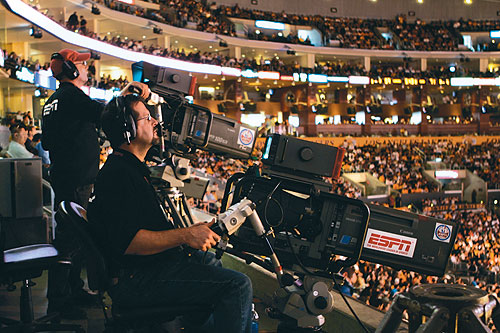
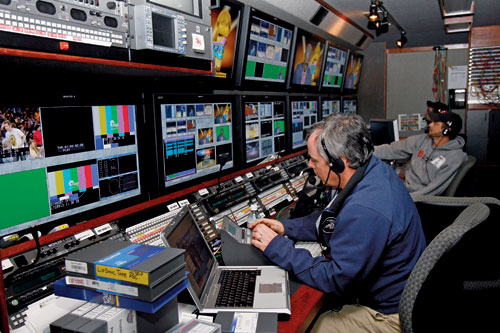
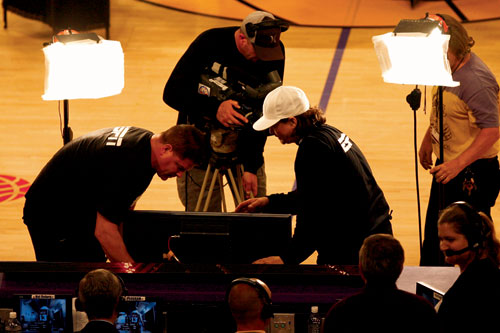 WARM UPS: Operators set up and run tests before the game.
WARM UPS: Operators set up and run tests before the game.Moore notes that most TV viewers are unable to take full advantage of high-definition technology. "High-def makes wide shots more appealing because the detail is so great," he says. "Unfortunately, we can't change our framing to the 16 x 9 thought process [of high definition] because the majority of our audience is watching 4 x 3. Later on, when the rest of the country catches up, it's going to be really fun for directors to actually use all that space."
As game day approaches, Moore consults with producer Wolfe, who orders the archival footage and coordinates the taped packages that augment the live action. Wolfe says that the bells and whistles of the digital age have only so much value. "When you're doing a big live-sports production, you get more equipment, you have more graphics, and you have more animation," he says. "The key thing is not to get taken over by the number of cameras and the new technology. We always have to remember what we're trying to do: give the viewer great access to the game—and, sometimes, an even better experience than if he were in the stadium."
Moore also prepares his cameramen for adjustments he wants them to make in the upcoming broadcast. Meanwhile, he is closely following the fortunes of the two teams that will meet for possible angles. Is Lakers' center Kwame Brown's ankle injury affecting his rebounding and scoring? Why did coach Phil Jackson decide to insert rookie guard Jordan Farmar into the starting lineup? What else is happening around the NBA that will affect this game?
On the day before the game, ABC typically sets up its two production trucks outside the arena. One truck contains the graphics crew, the musical effects coordinators and the 12-person staff that tracks the taped elements. Seated in close quarters in an adjacent truck are Moore, Wolfe, associate director Wilson, stage manager Zabriskie and other crew members.
In the days before the game, Moore will journey to the teams' hotel or practice facility to tape segments with the coaches and star players. Shot over a green screen, these interviews are edited into soundbites that will be inserted at appropriate moments during the broadcast. If Moore uses them while the game is in progress, he often employs a split screen so that viewers don't miss any action.
After the interviews are concluded, Moore turns off the cameras and talks to the coaches off the record. "It's a sharing of information that helps us understand where they're coming from and what to look for in terms of strategy or matchups," Moore says. "Sometimes, a player will tell us something new—like [Suns' forward] Shawn Marion mentioned that, before each game, he whispers something to [Lakers' forward] Lamar Odom. We'll alert the talent and we'll put a camera on that."
On game day, some four-and-a-half hours before tipoff, Moore gathers his camera crew for a meeting in the Chick Hearn Press Room at Staples Center. He hands out color-coded lineup cards, complete with each player's thumbnail photo and statistics, and then goes over specific assignments. "I need Kobe and Nash for the opener," he says, before instructing one cameraman to head to the parking lot to tape celebrity arrivals. "Get me three different stars," he says.
Moore also shares his notes from the previous broadcast, a game between the Golden State Warriors and the Dallas Mavericks. The dialogue goes back and forth as they discuss whether a close-up shot of Warriors' guard Baron Davis exiting the court was too tight. "The games are getting better—the emotion is more elevated and there's more reaction—now that we're getting deeper into the playoffs," he says. "I need you to hang in there, to linger on the shot, so you make sure to get the guys' frustration. Don't bust out till I'm screaming."
He fields several questions before examining the near-empty arena. Because Staples Center hosted an Arena Football League game the previous night, Moore was unable to check that his cameras were properly positioned until now. Satisfied that they are where he wants them, he returns to the truck and shows the announcers the taped elements that have been shot. "We have a lot of things ready," he says, "but that doesn't mean they're getting on the show. If you have a great game on the floor, the game has to be the first priority. If you have a 25-point blowout, a lot more things get in."
Next, Moore coordinates with Wilson on shooting several scenes that will be used during the earlier Chicago-Miami broadcast. "Who's got Kobe's arrival?" he says into his headset. A moment later, as Bryant steps out of his car, Moore is ready. "Standby camera 10, take 10," he says, and Bryant's walk to the locker room is captured on tape, one of several "bumps" that ABC will use to tease the L.A. game.

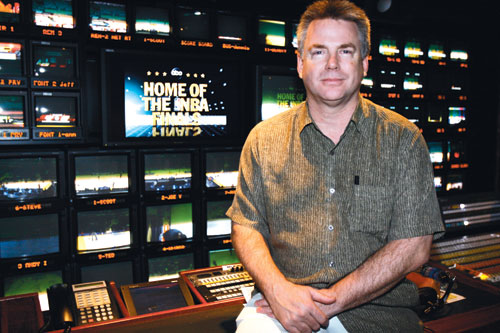 THE ELECTRIC EYE: A shot of fans the way the camera sees it.
THE ELECTRIC EYE: A shot of fans the way the camera sees it.Meanwhile, Wilson is in constant contact with master control in New York. As the communication hub of the operation, Wilson traffics the commercials and the sponsored parts of the broadcasts. He coordinates the timing of these elements with Wolfe and Moore and speaks directly to stage manager Melissa Horton, positioned next to the broadcasters on the court, so that the announcers know when to introduce them. "I'll tell Jimmy: 'Hey, we're in the break zone,' which gets him in the mindset of what graphics are rolling out and how he wants to cut to break," Wilson says.
With game time fast approaching, Moore admits to being "a little bit on edge. I don't really get nervous. I'm eager for the game to get going. Once it's rolling, the story just unfolds and we're there for it."
And, indeed, after the game goes live, the next three hours seem to pass in a blur. Moore calls out direction almost nonstop; during timeouts and other breaks, he consults with his cameramen and Wolfe. Only the game seems to disappoint: the Suns jump on the Lakers early and stay in control for the entire game, winning 113-100. (The Suns went on to win the series, 4-1.)
Still, Moore is delighted when his preparation work pays off. During the first half, after announcer Mike Breen mentions the mentor-student relationship that has developed between Lakers legend Kareem Abdul-Jabbar and L.A.'s teenage center Andrew Bynum, the youngster blocked a shot as if on cue. Cutting quickly to a tight shot of Abdul-Jabbar in the stands applauding Bynum's effort, Moore leans toward the screen and says, "Excellent, hold it, hold it. Nice job."
Later, when the Lakers' Kwame Brown suddenly runs to the locker room, sideline reporter Michele Tafoya and a cameraman followed. Shortly after, during what turned out to be a convenient break in the action, Tafoya was able to ask Brown about his injury on live television. "Great job, Michele," Moore says, as the camera then follows Brown back to the bench.
After the game, unwinding in the truck and munching on a sandwich, Moore calls the broadcast "a good show" despite the on-the-fly opener. "We had three different openings ready, but it's weird getting started when there's a game in front of you and you don't know when you're actually going on. It worked out well. We got on the air before the game so we got to establish the players, the coaches, and everything in Staples."
The next day, on the flight home to Mississippi, Moore will watch a DVD of the broadcast and start making notes. He's got just five days to prepare for his next game, a contest between the Toronto Raptors and the New Jersey Nets. He says he'll be ready. "What I love about live sports is that it is unscripted. Every day when we go to work, we get one chance to get it right because it's live. My job is to be prepared to make that one time work."